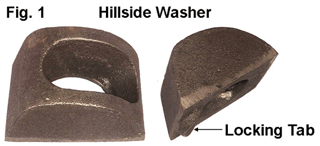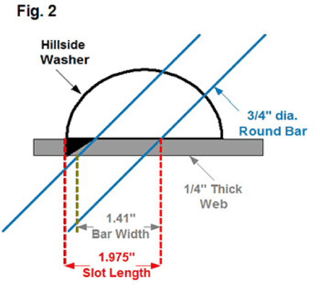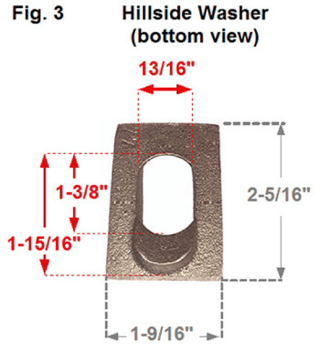 Hillside Washers can function in the basic form shown in Figure 1. All the necessary features are in place, along with the load strength to ensure durable performance.
Hillside Washers can function in the basic form shown in Figure 1. All the necessary features are in place, along with the load strength to ensure durable performance.
Things that should be considered when designing the turnbuckle or bracing rod assembly include 1) the thickness of the I-beam web or flange and 2) the size of the hole that is required for the turnbuckle rod, eye bolt, or whatever rod will pass through it. When dealing with the hole size, it is important to keep in mind that the turnbuckle rod will pass through at an angle. For purpose of this conversation, it will be assumed the angle is 45°, the rod is 3/4” in diameter, and the web is 1/4” thick.
 Note: Due to the rough casting method used to manufacture these hillside washers, all measurements are +/-.
Note: Due to the rough casting method used to manufacture these hillside washers, all measurements are +/-.
As shown in Figure 2 the 3/4” diameter round bar, at a 45° angle, requires a slot 1.41” long. The slot must also allow space for the locking tab (shown in black). Combined, the space required is 1.975”, which for simplicity or tooling purposes, would be enlarged to 2”.
Typically, the width of the slot requires no more than the standard bolt clearance of 1/16”, so the slot for this assembly would be 13/16” x 2”. Because the locking tab is at the front edge, the hillside washer is only supported on 3 sides.
 Using the dimensions shown in Figure 3, the area of the base is 3” sq. The area of the slot that will be cut in the web or flange is roughly 1-1/2 sq. inches. This leaves 1-1/2 sq. inches of steel surface on the 3 supported sides for the hillside washer to rest on.
Using the dimensions shown in Figure 3, the area of the base is 3” sq. The area of the slot that will be cut in the web or flange is roughly 1-1/2 sq. inches. This leaves 1-1/2 sq. inches of steel surface on the 3 supported sides for the hillside washer to rest on.
In most cases, the I-beam web or flange provides more than enough strength to withstand the force the hillside washer exerts on it. Typical wide flange I-beams always have flanges that are thicker than the web, so the strength will change based on what surface the hillside washer is mounted against. For example, a W14 x 61 beam will have a web thickness of .378” but an average flange thickness of .643”
The engineer or designer will make the calculations necessary to ensure the mounting surface is sufficiently strong to support the stress the assembly will put on it. One situation where this becomes an important concern is in Pre-Engineered Metal Buildings (PEMB). For two reasons these structures may involve lighter column and beams. First, the designs are intended to be built many times so any savings on material will multiply over the life of that design. Second, PEMB’s are done as one story structures mostly with peaked roofs, so the weight loads may not reach the same value as a flat roof.
Also, the PEMB employs thinner gauge Z or C channels as part of their integrated support structure which, if used in conjunction with bracing rods, may not have the yield strength to provide the necessary resistance under a load.
In cases where the web, flange, or Z-channel require additional support, the designer may call for a plate washer called a flange washer under the hillside washer to distribute the load over a larger area.





